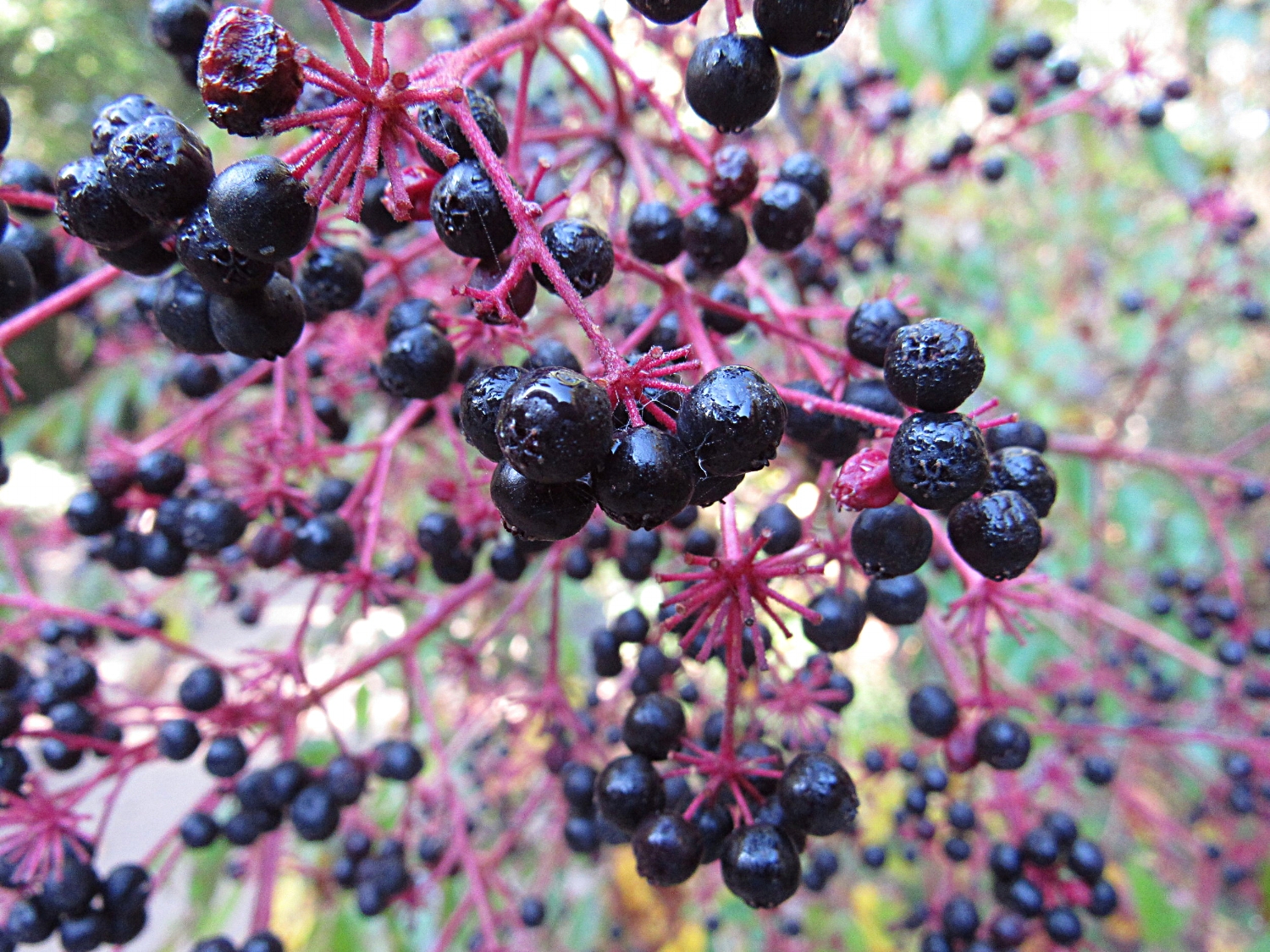Aralia spinosa, often called devil's walking stick, is commonly confused for the American elderberry. And just one glance at the plant reveals why: Aralia's dense clusters of dark purple berries hanging from vivid burgundy stems look strikingly like the American elder. The two species reach a similar size, thrive in the same environments, and bear fruit at about the same time. Aralia is especially common in the southern half of the East Coast, but its range extends well into New England. Yet while the American elder, Sambucus canadensis, as well as the European Sambucus nigra, are well-researched, time-tested wild medicinals, devil's walking stick has a more complicated story.
These ripe Aralia spinosa fruits are looking awfully similar to American elderberries.
So the big question is: was that really elderberry jelly you just ate? If you're starting to feel a little anxious at this point, a word of comfort: ripe Aralia berries are at most mildly toxic. If you eat a few ripe berries raw, you might get an upset stomach. A few more and your stomach might start sending them back. But if you cook the ripe berries, they seem to be safe to consume in normal amounts. I've scoured the internet and a few books, and can't find any instances of people getting sick from ripe, cooked Aralia berries. So you probably don't need to freak out.
Aralia spinosa sends out its smaller, often smooth branches in a distinctive way.
But before we get any deeper into the potential risks (and benefits) of consuming Aralia spinosa, lets look at a surefire way to identify it as opposed to Sambucus. The berries do look different, but I wouldn't rely on that. Below is a close-up of Aralia's stem. See those thorns? American elders have no thorns or spines of any kind. As you saw in the previous photo, the smaller branches may be smooth or have very limited thorns. But simply checking the main stalk for thorns will either immediately confirm or rule out Aralia spinosa.
The thicker, woody main stalk of Aralia spinosa. "Devil's walking stick" indeed.
The leaves look exceptionally similar. Immediately below are the leaves of Aralia spinosa; the next picture is the leaves of American elder. They look different enough in these two pictures, but American elder leaves are often closer in color and shape to the first photo. So while it's good to see the similarity in structure, and the trained botanist could easily tell the two apart, I'm personally much more comfortable just looking for thorns.
These leaves belong to Aralia spinosa, also known as Hercules' club.
These are the leaves of the American elder.
Now a word about the potential risks and benefits associated with Aralia spinosa. Some Indigenous Americans and early Europeans settlers referred to the plant as "toothache tree," but they valued the plant for much more than just treating toothaches. Today, however, it is rarely considered more than a decorative shrub. And as far as I can tell, there is not a single modern study on any medicinal aspect of Aralia spinosa. In light of this total lack of scientific research, it is at least interesting to look at some of the traditional and folk uses of the plant. Whether or not there is any truth to these uses is questionable.
The famous compendium A Modern Herbal, published by Mrs. M. Grieve in 1931, says that Aralia's fresh bark induces vomiting, but the dried bark acts as a stimulant. She also mentions that a tincture made from the berries is good for tooth pain. In fact of all its purported medical uses, relieving toothaches seems to be the most common I encountered. Another popular one was rheumatism: both Grieve and Benjamin Strobel, in his 1826 work The Medical Properties of the Aralia Spinosa, or Prickly Ash, mention the plant's effectiveness against rheumatism. Strobel mentions its emetic action as well, but considers this rather superfluous. Medicine had a long way to go in the early 19th century, but apparently they thought they had the whole "how-to-make-people-blow-chunks-thing" figured out pretty well.
I also found occasional mentions of the plant treating skin conditions, respiratory problems, and rattlesnake bites, among other things. But as far as peer-reviewed research goes... crickets.
The lack of research is a bit surprising to me considering the wealth of folklore surrounding the plant. I think all the old-time references to Aralia inducing vomiting should be taken seriously. It seems pretty well-established that eating parts of the plants other than the ripe cooked berries will effectively induce reverse-digestion. Touching the roots or bark of the plant has also been reported to cause skin reactions in some individuals, but I have not experienced this myself.
Aralia spinosa is not a plant I really recommend messing with. There's no scientific research to suggest the plant is beneficial, or even totally safe in the long term. I admit that I've made syrup out of curiosity, with zero observable ill-effects, but I wouldn't advise you to do the same. However, knowing how to identify devil's walking stick is critical if you want to gather wild elderberries.





